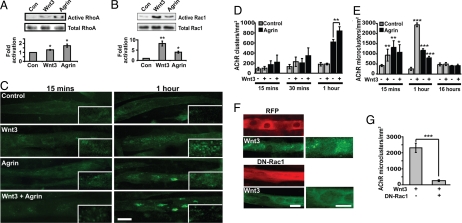Fig. 5.
Wnt3 induces a rapid increase in the formation of micro-clusters. (A) Pull-down assays from myotubes treated with Wnt3 or agrin show that Wnt3 induces a slight increase in endogenous activated Rho (1.5 fold), whereas agrin increases GTP-Rho levels to a greater extent (twofold; normalized to control, Left). (B) Rac1 assays from lysates reveal that both Wnt3 (eightfold) and agrin (fourfold) activate Rac1 within 15 min, compared with untreated controls (Left, normalized to 1). Total levels of Rac1 and RhoA were used as loading controls. The blots are representative of three independent experiments. (C) Time course of cluster formation. Myotubes were exposed to control, Wnt3, agrin, or both for 15 min or 1 h. After 15 min (Left), agrin, Wnt3, or both increase the number of micro-clusters. However, after 1 hour, Wnt3 alone induces a stronger effect (second panel, Right, inset). In contrast, agrin alone or both agrin and Wnt3 significantly increase the formation of large clusters (Lower, Right). (D) Quantification shows that Wnt3, agrin, or both do not affect the formation of large clusters after 15 or 30 min. However, agrin induces the formation of large clusters after 1 h (55% increase), with a further increase (26%) in the presence of Wnt3 (**P < 0.01). (E) Quantification reveals an increase in micro-cluster formation after 15 min in the presence of Wnt3 alone (**, P < 0.01), agrin alone (**, P < 0.01), or both (*, P < 0.05). After 1 h, the number of micro-clusters formed in response to Wnt3 alone is significantly increased (100% increase) compared with agrin treatment. In contrast, after 16 h treatment, the number of micro-clusters in all conditions is the same as in controls. (F) Wnt3 induces microcluster formation in RFP-transfected control myotubes after 1 h (Upper), whereas DN-Rac1 expression abolishes the effect of Wnt3 (Lower). (Scale bar, 20 μm.) (G) Quantification shows that DN-Rac1 reduces the formation of micro-clusters by ≈90% after 1 h exposure to Wnt3 compared with control RFP-expressing myotubes (***, P < 0.001).

